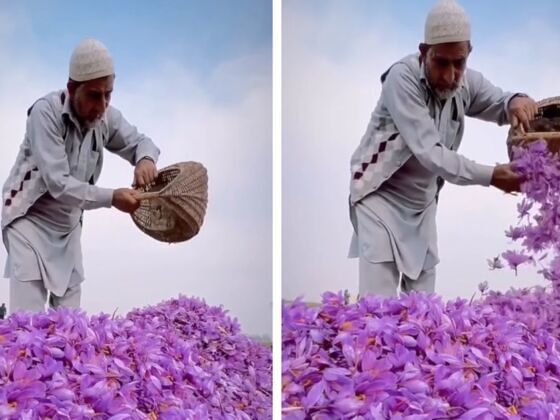Saffron is a spice that’s prized the world over for its yellow-orange hue and floral flavor. It’s a staple of various cuisines and iconic dishes from Spanish paella to Persian tachin, a baked rice dish from Iran that similarly spotlights saffron’s vibrancy. Not everyone familiar with the effect of cooking with saffron knows that the process of harvesting the spice is just as beautiful, however. But in Kashmir, India, the annual saffron harvest is a full-on spectacle, and it’s a wonderful reason to visit India’s northernmost region during the fall.

In Kashmir, India, Harvesting the World’s Priciest Spice Is a Magical Sight
@foodwtf Fact: It takes about 80,000 roses to produce 1lb of #saffron and the threads must be hand picked. That explains why it is the most expensive spice in the world📍Pampore, Kashmir 🎥 IG: @theculturegully #spicetok #foodie #foodtiktok #foodtravel ♬ Peace – Official Sound Studio
How to harvest saffron and when to visit Kashmir to see it
Saffron is made from the dried stigmas of crocus flowers. Each flower produces only three stigmas, which makes harvesting them labor-intensive and costly.
The saffron that’s grown and harvested in Kashmir is some of the finest in the world. This can be attributed to its unique growth cycle which begins with planting in May or June when temperatures are still mild. During these months, farmers sow the corms (or bulbs) of the crocus plants by hand, taking great care to ensure they’re planted at just the right depth and distance apart so that they get enough light and air to grow strong and healthy throughout summertime before being harvested in autumn when their blooming season begins. When October arrives, it’s time for farmers to start hand-harvesting their crop of saffron flowers. Each flower must be carefully plucked by hand as any damage can affect its quality.
In Kashmir, saffron harvesting is an ancient art form that has been passed down through generations of local farmers. Whole families take to the fields to pick each flower’s delicate stigmas one-by-one before drying them out slowly over several days until they become what we recognize as saffron threads. To dry the saffron, each flower is laid out on a flat surface where it can dry naturally in the sun for up to two days before being cut open and processed. The stigmas are then removed carefully so as not to leave any behind, as even trace amounts can spoil a batch of saffron completely. From there, the stigmas are cleaned, inspected, and sorted according to quality before being packed up ready for sale or export.
The harvesting season in Kashmir usually lasts between two and three weeks, during which time tourists can get an up-close look at how it’s done. Visitors can join a guided tour to see firsthand how locals extract the saffron from crocus flowers, as well as taste freshly prepared dishes cooked with saffron. It’s also a great place to pick up saffron as a souvenir to bring home straight from the source. Remember that buying directly from farmers helps support local businesses and encourages sustainable practices in farming communities throughout Kashmir.